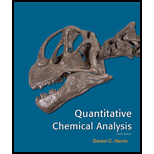
(a)
Interpretation:
Whether the two given methods agree with each other at the
Concept Introduction:
Comparing replicate measurements:
When the two standard deviations are not significantly different from each other, the equation used is:
To Give: Whether the two given methods agree with each other at the
(a)
Answer to Problem 4.23P
The difference between the two methods of rain water is not significant.
The difference between the two methods of drinking water is not significant.
Explanation of Solution
Given data:
The results for the measurement of nitrite

Figure 1
Rainwater:
Let us assume,
The mean
The mean
The number of measurement of spectrophotometry method is
The number of measurement of spectrophotometry methods is
F-Test:
First, calculate F-Test and find whether the standard deviations of the given methods are significant or not.
For
Hence, the standard deviations of two sets of measurements are not significantly different.
Therefore, the equation used is:
Calculate
Calculate the t value:
The value of
Here,
Therefore, the difference is not significant.
Drinking water:
Let us assume,
The mean
The mean
The number of measurement of spectrophotometry method is
The number of measurement of spectrophotometry methods is
F-Test:
First, calculate F-Test and find whether the standard deviations of the given methods are significant or not.
For
Hence, the standard deviations of two sets of measurements are not significantly different.
Therefore, the equation used is:
Calculate
Calculate the t value:
The value of
Here,
Therefore, the difference is not significant.
The difference between the two methods of rain water is found out to be not significant.
The difference between the two methods of drinking water is found out to be not significant.
(b)
Interpretation:
Whether the drinking water contain more nitrite than the rain water at the
Concept Introduction:
Comparing replicate measurements:
When the two standard deviations are not significantly different from each other, the equation used is:
To Give: Whether the drinking water contain more nitrite than the rain water at the
(b)
Answer to Problem 4.23P
At the
Explanation of Solution
Given data:
The results for the measurement of nitrite

Figure 1
Gas chromatography:
The equation used is:
Calculate
Calculate the t value:
The value of
Here,
Therefore, the difference is not significant.
Spectrophotometry:
The equation used is:
Calculate
Calculate the t value:
The value of
Here,
Therefore, the difference is not significant.
At the
Want to see more full solutions like this?
Chapter 4 Solutions
Quantitative Chemical Analysis
- In a benzene derivative that has -CH2CH3, indicate how it can be substituted by -COOH.arrow_forwardIn a sulfonated derivative of benzene, indicate how -SO3H can be eliminated.arrow_forwardWhat is the equilibrium expression (law of mass action) for the following reaction:CO2 (g) + H2O (l) ⇋ H+ (aq) + HCO3- (aq)arrow_forward
- Indicate the compound resulting from adding NaOH cyclopentane-CH2-CHO.arrow_forwardUse the provided information to calculate Kc for the following reaction at 550 °C: H2(g) + CO2(g) ⇌ CO(g) + H2O(g) Kc = ?CoO(s) + CO(g) ⇌ Co(s) + CO2(g) Kc1 = 490CoO(s) + H2(g) ⇌ Co(s) + H2O(g) Kc2 = 67arrow_forwardCalculate Kc for the reaction: I2 (g) ⇋ 2 I (g) Kp = 6.26 x 10-22 at 298Karrow_forward
- For each scenario below, select the color of the solution using the indicator thymol blue during the titration. When you first add indicator to your Na2CO3solution, the solution is basic (pH ~10), and the color is ["", "", "", "", ""] . At the equivalence point for the titration, the moles of added HCl are equal to the moles of Na2CO3. One drop (or less!) past this is called the endpoint. The added HCl begins to titrate the thymol blue indicator itself. At the endpoint, the indicator color is ["", "", "", "", ""] . When you weren't paying attention and added too much HCl (~12 mL extra), the color is ["", "", "", "", ""] . When you really weren't paying attention and reached the second equivalence point of Na2CO3, the color isarrow_forwardTo convert cyclopentane-CH2-CHO to cyclopentane-CH2-CH3, compound A is added, followed by (CH3)3CO-K+, DMS at 100oC. Indicate which compound A is.arrow_forwardIndicate how to obtain the compound 2-Hydroxy-2-phenylacetonitrile from phenylmethanol.arrow_forward
- Indicate the reagent needed to go from cyclopentane-CH2-CHO to cyclopentane-CH2-CH=CH-C6H5.arrow_forwardesc Write the systematic name of each organic molecule: structure CH3 CH3-C=CH2 CH3-CH2-C-CH2-CH3 CH-CH3 CH3 ☐ ☐ ☐ CI-CH-CH=CH2 Explanation Check F1 F2 name 80 F3 F4 F5 F6 A 7 ! 2 # 3 4 % 5 6 & 7 Q W E R Y FT 2025 Mcarrow_forwardTwo reactants X and Z are required to convert the compound CH3-CH2-CH2Br to the compound CH3-CH2-CH=P(C6H5)3. State reactants X and Z.arrow_forward
 ChemistryChemistryISBN:9781305957404Author:Steven S. Zumdahl, Susan A. Zumdahl, Donald J. DeCostePublisher:Cengage Learning
ChemistryChemistryISBN:9781305957404Author:Steven S. Zumdahl, Susan A. Zumdahl, Donald J. DeCostePublisher:Cengage Learning ChemistryChemistryISBN:9781259911156Author:Raymond Chang Dr., Jason Overby ProfessorPublisher:McGraw-Hill Education
ChemistryChemistryISBN:9781259911156Author:Raymond Chang Dr., Jason Overby ProfessorPublisher:McGraw-Hill Education Principles of Instrumental AnalysisChemistryISBN:9781305577213Author:Douglas A. Skoog, F. James Holler, Stanley R. CrouchPublisher:Cengage Learning
Principles of Instrumental AnalysisChemistryISBN:9781305577213Author:Douglas A. Skoog, F. James Holler, Stanley R. CrouchPublisher:Cengage Learning Organic ChemistryChemistryISBN:9780078021558Author:Janice Gorzynski Smith Dr.Publisher:McGraw-Hill Education
Organic ChemistryChemistryISBN:9780078021558Author:Janice Gorzynski Smith Dr.Publisher:McGraw-Hill Education Chemistry: Principles and ReactionsChemistryISBN:9781305079373Author:William L. Masterton, Cecile N. HurleyPublisher:Cengage Learning
Chemistry: Principles and ReactionsChemistryISBN:9781305079373Author:William L. Masterton, Cecile N. HurleyPublisher:Cengage Learning Elementary Principles of Chemical Processes, Bind...ChemistryISBN:9781118431221Author:Richard M. Felder, Ronald W. Rousseau, Lisa G. BullardPublisher:WILEY
Elementary Principles of Chemical Processes, Bind...ChemistryISBN:9781118431221Author:Richard M. Felder, Ronald W. Rousseau, Lisa G. BullardPublisher:WILEY





